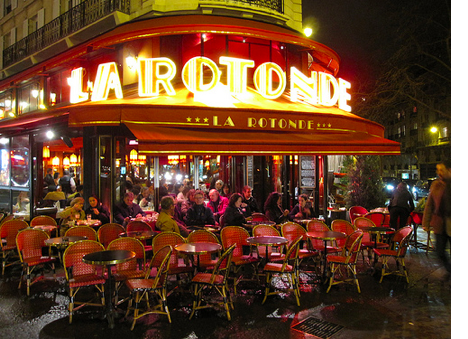Some Parisian waterholes sometimes stir fierce passions,even now. That curvaceous left bank café, La Rotonde, is one such. Even its syllables have a lovely rotundity as they roll off the tongue. In fact, the name suggests not its shape but its location. La Rotonde (in plain English, ‘the Roundabout’) sits solidly astride a noisy boulevard in Montparnasse where cars whizz by, day and night.
La Rotonde Boulevard Montparnasse Paris
It opened as a café/brasserie in 1911, next door to a butcher’s shop and soon became the sort of place you could happily spend half your life in. Spaniards, itinerant Americans, Russians, Swedes, Poles, British and surprisingly well down the list, a smattering of French, made La Rotonde their other home - and sometimes their bank. It was cheap, warm, open all hours and happily disreputable.
Picasso, Braque, Modigliani, Soutine and Diego Rivera were just another batch of newly arrived, improvident painters among the artists, poseurs, exiles, drunks, anarchists and layabouts migrating into the low-rent doss houses and tenements of Montparnasse. It seems that everyone, from Trotsky to Kiki of Montparnasse, with something interesting to say, or show or sell, even if only themselves, turned up in La Rotonde . Its wily patron, Victor Libion, made his fortune by making them all welcome.
‘Papa Libion’, as he became to his regular customers, allowed hard-up artists to pay their bills with a painting or sketch. It was a good investment. Several customers, Picasso among them, painted the café interior and La Rotonde’s walls sported paintings and drawings by some of the best around. Modigliani, perennially flat broke, paid for his drinks with pages torn from the sketchbook he carried. Customers who repaid the loans got their paintings back. La Rotonde became the artists’ pawnshop.
La Rotonde’s motley crew included several South African writers, and this has always attracted me. The itinerant journalist, Bill Ryall (under his pen name, William Bolitho) published ‘Twelve Against the Gods’. It’s an endearing, somewhat boy’s own study of a dozen remarkable lives, from Alexander the Great to Casanova. Ryall’s own heroism in the Great War endeared him to Hemingway, who considered him a genius.
“We are born adventurers,” Bolitho writes, “and the love of adventures never leaves us till we are very old; old, timid men, in whose interest it is that adventure should quite die out. This is why all the poets are on one side, and all the laws on the other; for laws are made by, and usually for, old men."
Then there was Beatrice Hastings, a satirist with a cutthroat wit and another regular at La Rotonde,during the First World War. She came from Port Elizabeth, via London to Montparnasse, a transposition in the early years of the 20th century that I find hard to imagine. After a disastrous marriage to a prize fighter, she moved to London and then Montparnasse. Her first meeting with Modigliani did not go at all well and she left a typically ruthless portrait of the drunk, coked-up painter:
‘Hashish and cognac. Totally unimpressed. No idea who he was. He looked frightfully ferocious and vulpine. Met him again at La Rotonde... clean-shaven and charming. He elegantly doffed his hat, went bright red and invited me to come and see his works.’
Beatrice Hastings Amadeo Modigliani 1915
That second meeting in La Rotonde seems to have done the trick. She moved into an apartment with Modigliani and he painted her over a dozen times in his short, tormented life. Hastings and Ryall both died young and deserve to be better remembered.
Ernest Hemingway loved and loathed La Rotonde in equal measure and wrote off the café, calling it ‘a showplace for tourists in search of atmosphere...you can find anything you are looking for at the Rotonde, except serious artists. ...they are nearly all loafers.’
I’d say he was quite probably right about that. But how many real artists can you fit around a bar at any time? I wonder what other poets and painters in La Rotonde, in the 1920’s, felt about Hemingway, when this gauche young American first showed up? The death of La Rotonde has been predicted over the decades. Yet, it remains and survives and prospers, even from time to time it recovers its taste for violent argument and political fisticuffs.
A few years ago, there were riots outside La Rotonde. Very French riots. These began with demonstrations stoked by the ‘Yellow Vests,’ an unruly lot in high-viz waistcoats and a taste for pitching their tents on traffic islands and shouting at passersby and whose disappointing ideas of revolution involved setting fire to radar cameras on the autoroutes. They were joined by protestors furious with President Macron’s plans to lower the pension age. Macron was known to be very fond of the seafood at La Rotonde. He dined there whenever he could and was on record as saying he always felt happy in the café.
What better way to show your displeasure than to attack Macron’s favourite bistro? And where else but Paris would this be an act of revolutionary daring? The demonstrators never got inside to disturb the diners. Armoured riot police carrying guns, shields and batons, lined the sidewalks. Seated comfortably on the cafe’s red velour banquettes the patrons looked on. The demonstrators set fire to the roof. But the blaze was soon extinguished and the evening was declared a draw. La Rotonde was once again famous for unsightly behaviour, the demonstrators had made their point and everyone went home happy. It was almost like old times.
Christopher Hope






